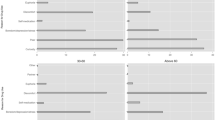Abstract
Using data from the National Survey on Drug Use and Health, evidence of income inferiority in illegal drug consumption is presented. This is done by estimation of binary choice probit models with endogenous regressors. The endogeneity of income with regard to drug consumption is considered and the more efficient three-stage least squares procedures have been implemented. In general, the results indicate that accounting for endogeneity improves results on income inferiority with regard to drug consumption. An implication of this study is that some form of income distribution policies towards the poor might be more effective in controlling substance abuse. It also points out the regressive nature of the government’s substance abuse program.
Similar content being viewed by others
Notes
Originally, the 1991 study consists of 32,594 observations on 1,283 variables; the 1992 study consists of 28,832 observations on 1360 variables; the 1993 study consists of 26,489 observations on 1,380 variables. Deleting missing observations on different explanatory variables, we arrive at 87,126 observations for the entire data set.
This form of health insurance is different from other government programs that pay medical care (e.g., MEDICAID) or help pay medical bills. This is also different from all forms of insurance provided to military personnel (in active duty/retired) or their dependants, as well as disabled persons. The instrument used here is a measure of health insurance purchased individually by paying premiums to a private health insurance and separate from membership in a HMO or those provided by current or former employer or union.
Given that the NSDUH report only the Census region and division of the respondents’ place of residence, it was not possible to use more disaggregated STRIDE data on drug prices that report statewide drug prices on the basis of size and quality of purchase. More recent editions of the NSDUH have even stopped reporting these geographical information (for anonymity purposes), thus, making use of any drug price information almost impossible with these latter datasets.
The 2SLS estimates are not separately reported in the paper and can be obtained from the author on request.
References
Becker, G. S., & Murphy, K. M. (1988). A theory of rational addiction. Journal of Political Economy, 96(4), 675–700.
Chaloupka, F. J., Michael, G., & Tauras, J. A. (1999). The demand for cocaine and marijuana by youth. In F. J. Chaloupka, G. Michael, W. K. Bickel, & H. Saffer (Ed.), The economic analysis of substance use and abuse: An integration of econometric and behavioral research (pp. 251–278). NBER, Chicago, IL: University of Chicago Press.
Gill, A. M., & Michaels, R. J. (1992). Does drug use lower wages? Industrial and Labor Relations Review, 45(3), 419–434.
Hausman, J. A. (1978). Specification tests in econometrics. Econometrica, 46(6), 1251–1271.
Hausman, J. A. (1983). Specification and estimation of simultaneous equations models. In Z. Griliches & M. D. Intriligator (Eds.), Handbook of econometrics (pp. 391–448). Amsterdam: Elsevier.
Holcombe, R. G. (1995). Public policy and the quality of life: market incentives versus government planning. Westport CT: Greenwood Press.
Kaestner, R. (1991). The effect of illicit drug use on the wages of young adults. Journal of Labor Economics, 9(4), 381–412.
Kaestner, R. (1994a). New estimates of the effect of marijuana and cocaine use on wages. Industrial and Labor Relations Review, 47(3), 454–470.
Kaestner, R. (1994b). The effect of illicit drug use on the labor supply of young adults. Journal of Human Resources, 29(1), 126–155.
Kaestner, R. (1998). Illicit drug use and labor market outcomes: A review of economic theory and its empirical implications. Journal of Drug Issues, 28(3), 663–680.
Kenkel, D. S., Ribar, D. C., Cook, P. J., & Peltzman S. (1994). Alcohol consumption and young adults’ socioeconomic status. Brookings Papers on Economic Activity. Microeconomics, 1994, 119–175.
Saffer, H., & Chaloupka, F. (1999). The demand for illicit drugs. Economic Enquiry, 37(3), 401–411.
Sickles, R., & Taubman, P. (1991). Who uses illegal drugs? American Economic Review, 81(2), 248–251.
Thornton, M. (1991). Economists on illegal drugs: A survey of the profession. Atlantic Economic Journal, 19(2), 73.
Thornton, M. (2004). Prohibition vs. legalization: Do economists reach a conclusion on drug policy? Econ Journal Watch, 1(1), 82–105.
Acknowledgement
The author wishes to thank the program participants, including the discussant Justo Manrique, for helpful comments. The author also thanks William Trumbull, Stratford Douglas, Subhayu Bandyopadhayay, Alexei Egorov, and Arabinda Basistha for their useful comments and suggestions. All remaining errors are mine.
Author information
Authors and Affiliations
Corresponding author
Appendix
Appendix
Rights and permissions
About this article
Cite this article
Roy, S. Are Illegal Drugs Inferior Goods in the US?. Atl Econ J 35, 303–314 (2007). https://doi.org/10.1007/s11293-007-9071-0
Received:
Published:
Issue Date:
DOI: https://doi.org/10.1007/s11293-007-9071-0




